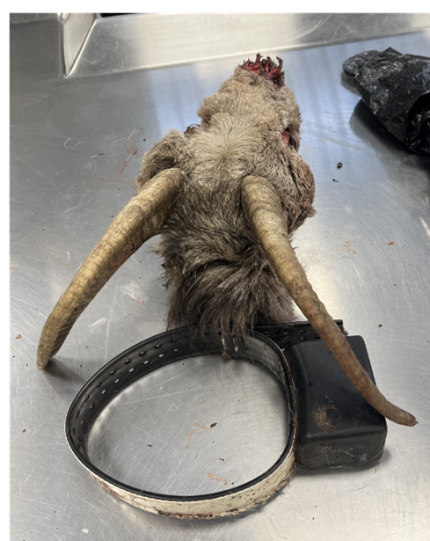
Wildlife Program report: Jan. 16-31, 2024
Managing Wildlife Populations
Bighorn Sheep: Biologist Brinkman received a report from a member of the public that had discovered a collared bighorn sheep that had died in the Lincoln Cliffs area. The sheep was presumed to have been killed and eaten by a cougar, the reporting party observed tracks around the kill site and took pictures that were verified by Biologist Brinkman.
Although the kill looked relatively fresh, the carcass was almost completely consumed. The skull was still intact, as was the collar. The remains were collected by the reporting party and were dropped off at the regional office in Spokane. Upon receiving the collar, Biologist Lowe searched the bighorn collar database for the Lincoln Cliffs herd and determined that this ewe was collared as an adult in 2015.

Tucannon Bighorn Sheep Herd: A ewe with a GPS collar was sending off a mortality signal and had a cluster of points in one spot. Wildlife Area Manager Dingman and Natural Resource Technician Tritt located her and determined the collar was malfunctioning. The ewe was standing up and feeding and looked healthy. Later in the week Dingman found 12 of the 13 sheep in the Tucannon herd. The one half-curl ram is still missing.
Deer Road Surveys: Biologist Vekasy compiled summaries of post-hunt deer surveys for District 3. District staff members counted and classified 1,353 mule deer for a buck to100 doe ratio of 0.19 and a fawn to100 doe ratio of 0.55. Incidental to mule deer counts, we also counted and classified 406 white-tailed deer for a buck to100 doe ratio of 0.28 and fawn to100 doe ratio of 0.62. Mule deer buck ratios were lower than the previous 5-year mean but within the 95% Confidence Interval (CI), while fawn ratios were higher than the 5-year mean but also within the 95% CI. White-tailed ratios for both buck and fawn were both above the 5-year means but within the 95% CIs.
Bighorn Sheep Capture: Vekasy worked with District Biologist Wik to dart bighorn sheep lambs in the Asotin Creek herd. Lambs are being collared to detect adolescent movements of bighorns, providing new information for risk-management models for contact with domestic sheep and goat herds. In addition, the recent detection of M. ovi. in bighorn sheep from multiple Hells Canyon herds makes disease testing a priority.
Swan: Biologist Brinkman received a swan carcass that was found by a hunter while waterfowl hunting. This was the only bird carcass found in the area, veterinary staff members decided to not test for Highly Pathogenic Avian Influenza (HPAI) at this time. However, if additional bird carcasses are discovered in that area, tests will be conducted to determine if a localized HPAI outbreak may have occurred.
Providing Recreation Opportunities
Recreation Access Site Maintenance: Maintenance Mechanic Heimgartner and Natural Resource Technician Nielsen cleaned and serviced access areas across the district.
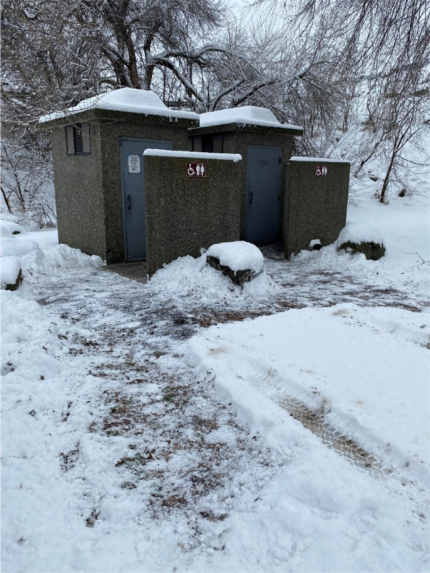
Sportsman Contacts: Wildlife Conflict Specialist Wade spoke with two muzzleloader elk hunters this week and assisted them with identifying a potential area to hunt. One hunter contacted Wade to let him know that he had successfully harvested a cow elk on a Washington Department of Fish and Wildlife Register to Hunt area, Wade had recommended. Wade assisted the hunter with contacting the owner of the property to gain vehicle access to the property so that the hunter could retrieve the elk. The hunter thanked Wade and Natural Resource Technician Heitstuman for their information sharing and assistance.
Hunting Access: Private Lands Biologist Hadley spoke to a gentleman regarding hunting access for next upland bird season. He was looking for properties to hunt with his daughter. Hadley recommended several access sites in Walla Walla and Columbia County and forwarded information of a couple local hunting chapters that have a strong youth program and women program to see if his daughter would be interested. He was very appreciative.
Sign removal: Private Lands Biologist Hadley began removing access signs on a property that was recently removed from a Washington State Department of Fish and Wildlife hunting access program in Columbia County.
Providing Conflict Prevention and Education
Wild Game Retrieval: Wildlife Conflict Specialist Samsill picked up a dead buck deer and a dead bull moose calf from two different properties in Ferry County. The carcasses were transported to the Wildlife Health Lab at the Spokane Regional Office and will be used at an upcoming necropsy training.
Cougar Sighting: Wildlife Conflict Specialist Samsill followed up on a series of cougar sightings in Springdale. Upon speaking to the reporting party, Samsill determined that they had never actually seen a cougar but believed a cougar was frequenting their property based on grainy security camera footage and tracks. Although Samsill was unable to view the videos the reporting party referred to, pictures of tracks indicated that a large dog was frequenting the property instead of a cougar.
Elk Damage: Wildlife Conflict Specialist Kolb spoke with a Spokane County landowner about on-going elk damage to a haystack. Advice was provided and the producer is considering entering into a Damage Prevention Cooperative Agreement
Wolf Non-Lethals: Wildlife Conflict Specialist Kolb responded to a proactive request for non-lethal support from a Columbia County producer who will start calving soon. The calving pastures are within the Columbia pack territory and the producer has experienced wolf-livestock interactions in previous years. Kolb dropped off foxlights and offered to help set up fladry once calves start hitting the ground.
Elk Damage: Wildlife Conflict Specialist Samsill responded to the report of elk consuming and damaging haystacks in Fruitland. Samsill performed a site visit and provided the producer with a landowner kill permit. Samsill offered to erect electric fencing around the haystack, however the producer decided to stack unwanted moldy hay bales around the hay he intends to feed to his livestock.
This acted as a barrier to prevent elk from reaching the quality hay inside. The producer requested additional damage permits. Samsill informed the producer that a Damage Prevention Cooperative Agreement for Crop Damage (DPCA) contract would need to be signed and the producer would need to commit to a hunting access option before additional permits could be issued. The producer agreed to sign a DPCA and asked to be added to the landowner access list for elk and turkey hunting.
Stuck Deer: Wildlife Conflict Specialist Kolb was contacted by Wildlife Services concerning a deer stuck on a landing at Lower Monumental Dam. Kolb contacted the Corps of Engineers and coordinated dam access. The location of the deer impacted contracted work plans at the dam. Numerous Washington Department of Fish and Wildlife and Corps of Engineers staff members assisted with the effort. The deer was removed from the landing and scheduled work was able to be resumed.
Clarkston Deer Call: Wildlife Conflict Specialist Wade responded to two deer calls this week. The first call was a report of a deer that was deceased in an absentee homeowner’s lawn. When Wade contacted the homeowner, they had already arranged to have the carcass removed. The second call was a report of a deer that was unable to stand. Wade and Natural Resource Technician Heitstuman responded to the area to evaluate the deer. They determined that euthanizing the deer and removing the carcass for Chronic Wasting Disease (CWD) sampling was the best course of action. Upon further inspection, it was determined that the deer was infested by ticks. Natural Resource Technician Heitstuman collected CWD samples and disposed of the carcass.
Haystack Damage: Natural Resource Technician Harris followed up on a complaint of elk damage to a haystack in Ferry County. The producer reported that they had setup their own electric fence around the haystack to protect it from the elk, but the elk managed to destroy the fence beyond repair. Harris issued a kill permit and loaned the producer an electric fence kit to protect the haystack from further losses.
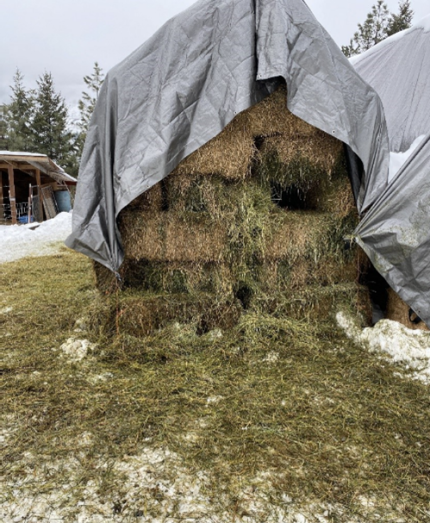
Asotin County Wolf Activity: Natural Resource Technician Heitstuman responded with Supervisor Wade to a potential depredation in the Grande Rhonde area. The Radio Active Guard (RAG) Box was deployed, and Foxlights were put up at several locations.
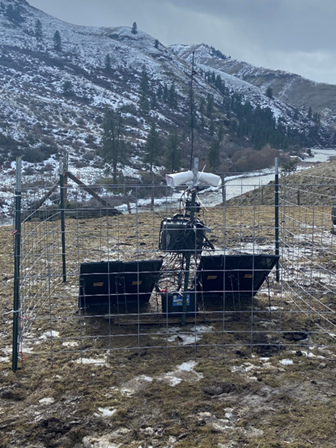
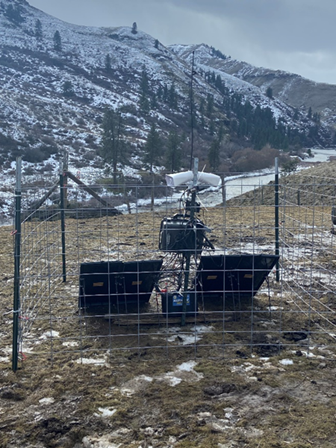
Conserving Natural Landscapes
Lands and Facilities Check: Natural Resource Technicians Meisner and Hammons cut up and cleared some dead trees that had succumbed from the Lick Creek fire and came down in a windstorm. The trees blocked access and made a mess. Wade also checked the Smoothing Iron house and placed a trail camera in Warner Gulch.
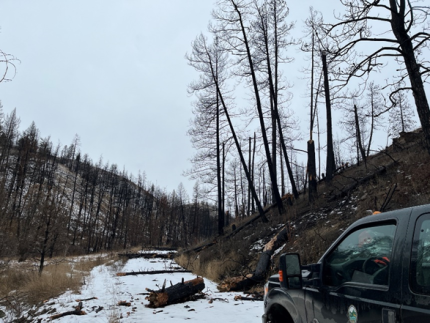
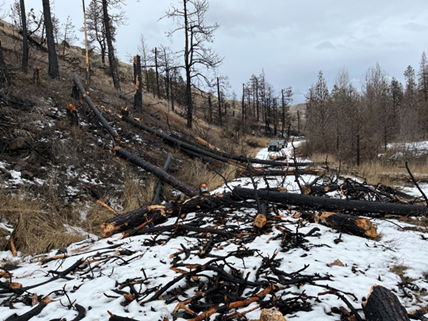
Conducting Business Operations and Policy
Grant Applications: Natural Resource Technician Nizer followed up with Pheasants Forever Spokane Chapter to give them more information about a site that could be a great habitat planting area. Nizer gave pictures of the site as well as a report that was taken during a site evaluation.
Natural Resource Technician Nizer applied for an internal grant for turkey habitat that was applied for last year and requested more funding to continue habitat work for roosting, nesting, and brood rearing habitat. The total amount requested for the project was $5,000. Maps were created through GIS of the updated planting areas.
General Facilities and Equipment Maintenance and Repairs: Sherman Creek Wildlife Area Assistant Manager Palmer spent a good amount of time plowing snow at the wildlife area headquarters. Between six and ten inches of snow fell between Tuesday and Friday in Spokane and northeastern Washington. North Region 1 Access Area Manager Dziekan spent a fair bit of time removing snow from parking lots at access areas and the Region 1 headquarter facilities, and Dziekan made sure sidewalks were ice-free.
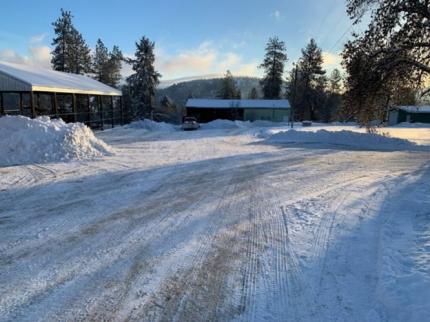
Administrative Duties: Dziekan began the process of updating specifications for his career seasonal employee, changing term length from six months to nine months. The change will provide more stability for the Incumbent Natural Resource Technician Brant but it is also beneficial to Research Scientist DeVivo.
Brant will still be working with Dziekan on access areas for six months out of the year, and for the other three months he will be doing Chronic Wasting Disease (CWD) surveillance work. With the term change, DeVivo won’t have to worry about recruiting candidates for a three-month position, but will already have an employee onboarded, trained, and ready to sample.
Brant will get some biology work that he can put on his resume to go with his new biology degree. This will help make him more able to meet his career goal of becoming a biologist. So far, Dziekan has created a ticket to change the season length, and he has received approval from Washington Association of Fish & Wildlife Professionals (WAFWP) for the change, which will come with no loss of off-season benefits.
Other
W.T. Wooten Wildlife Area: Natural Resource Technician Jensen found a postcard from 1942 for sale on eBay that is a photo of the W.T. Wooten Wildlife Area taken just north of the headquarters. Wildlife Area Manager Dingman was able to get the postcard photo enlarged and printed on metal to hang in the W.T. Wooten headquarters.
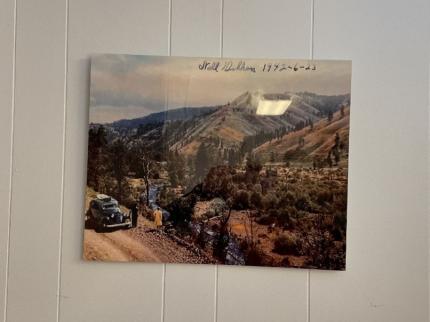
Managing Wildlife Populations
Trapped, Sick and Injured Wildlife: Biologists in District 5 have been receiving several phone calls regarding deer that have been stuck in the east-low canal. Biologists have teamed up with the Adams County Irrigation District Office in setting out deer escape ramps in areas where it is most common for deer to be found trapped. Along with the escape ramps, there are a couple of maintenance ramps that are located throughout the canal for irrigation district employees to get equipment into the canal that deer are also able to easily access should they walk along the canal far enough to find it.
Northern Leopard Frogs: Biologists Nason, Dougherty, and Clements are continuing to plan the 2024 northern leopard frog field season. They have also worked with the broader northern leopard frog team to identify priority actions for conservation, including DNA analysis of frogs surveyed in the 2023 season and dedicated bullfrog management.
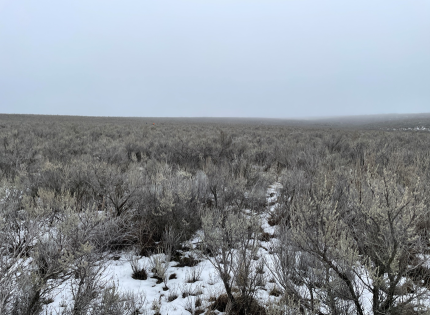
Pygmy Rabbits: District 5 staff members, including Biologists Nason and Dougherty, have continued to support the pygmy rabbit team with their winter burrow survey efforts. Despite challenges with staff member turnover and melting snow, the team has successfully completed survey transects, identified active burrows, and collected samples for DNA analysis.
Pygmy Rabbit Survey: Biologists Cook and Morris assisted the pygmy rabbit recovery team with winter surveys looking for active burrows and collecting fecal pellets for DNA sampling. Snow helps with surveys, but the day grew wetter as the warmer temperatures continued to melt the snow. Surveys include walking in a zig-zag pattern through pygmy rabbit habitat and looking for signs of use such as trails, tracks, scat, and burrows. These surveys help determine occupancy and numbers of rabbits in both known and potential pygmy rabbit habitat.
Waterfowl: Biologist Clements spent a handful of days in January organizing a volunteer project reconstructing hen mallard nesting tubes with the Washington Waterfowl Association (WWA), Moses Lake chapter. Clements went out with a Washington Conservation Corps (WCC) crew to collect over 20 nest tubes to disassemble and reassemble with new straw and orchard grass.
With the help of four WWA members plus the WCC crew membrs, they were able to accomplish reassembling 30 tubes. The next day, the WCC crew members and Biologist Clements went out to redeploy the tubes to their appropriate stands. The district team will follow up in the spring to see if the nesting tubes are being utilized by any mallard hens and if any clutches are successful.
Along with the mallard nest tubes, Biologist Clements has been reaching out and connecting with several dark goose hunters that have harvested geese with GPS collars on them. The hunters have been providing extremely helpful information in regards to their harvest as well as being fairly quick to exchange the real GPS collars for replicas that have been provided to WDFW staff members from Alaska Department of Fish and Game. With the exchange of collars and information on the harvest, Alaska Department of Fish and Game biologists are sending hunters certificates and maps of the movements associated with the collars. Clements has collected over ten collars that have been harvested in in the Columbia Basin this season.
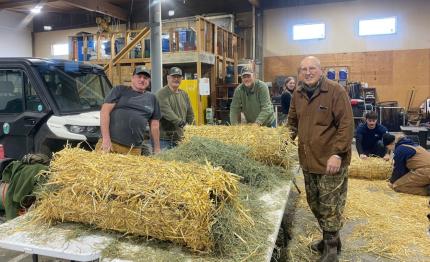
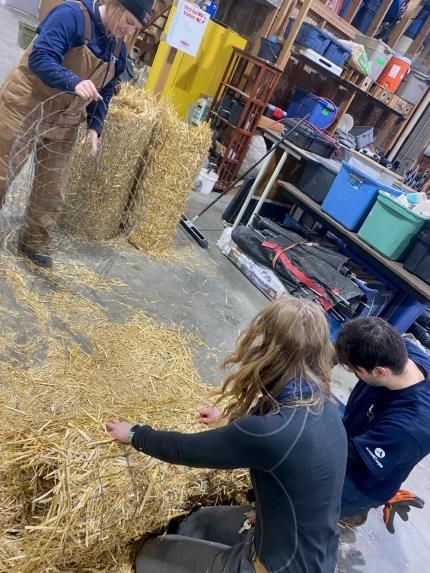
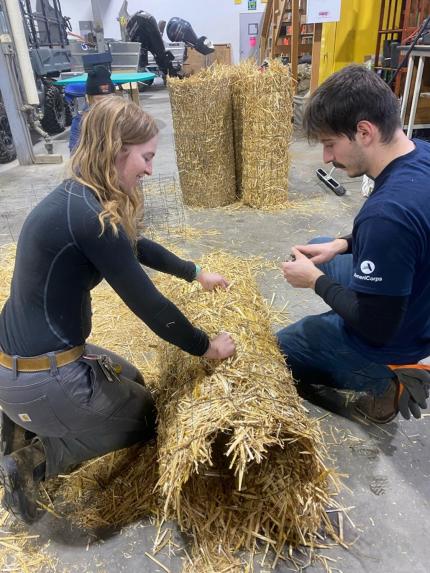
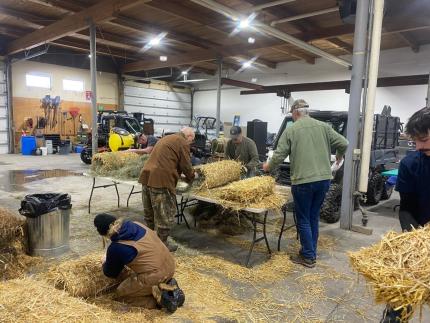
Providing Recreation Opportunities
Hunter Access: Biologist Morris checked fields enrolled in our Waterfowl Habitat and Access Program. Some hunters had success harvesting both waterfowl and upland birds on these sites. Biologist Morris also worked with landowners to start updating two hunter access contracts that expired this year (one Hunt by Written Permission and one Feel Free to Hunt).
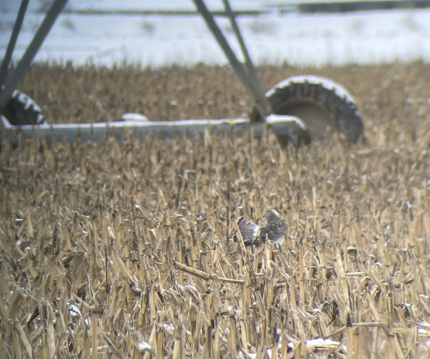
Conserving Natural Landscapes
Habitat Plots: Biologist Cook created an initial habitat improvement plan that would help deal with invasive common reed and Russian olive trees in a wet circle corner. The landowner was excited by the prospects of habitat improvement and Cook shared the plan. If the landowner approves the project and potential permitting is approved, field work can begin this spring.
Biologist Morris checked an established habitat plot to see if there was evidence of wildlife use during the winter. He saw upland game bird and mule deer signs in the area. This habitat plot provides valuable cover and forage for game and non-game species throughout the year.
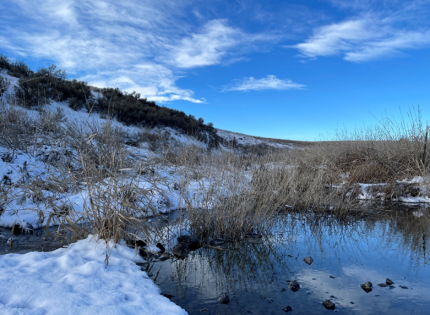
Other
Specialist Heilhecker had a busy couple of weeks. She took her vehicle in for service and submitted her fingerprints to Washington State Patrol for her period review. Then she boarded a flight for the annual wolf population survey.
Wildlife Sightings: While out checking local conditions Biologist Morris spotted several great blue herons, swans, bald eagles, and other wildlife along Moses Lake.
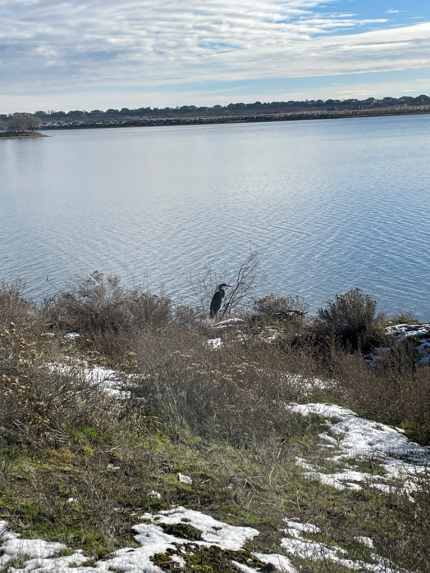
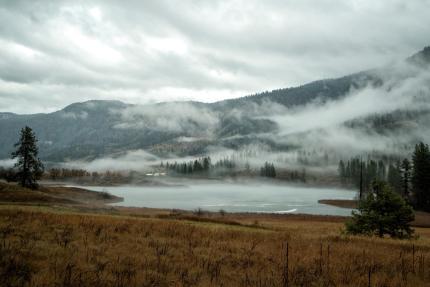
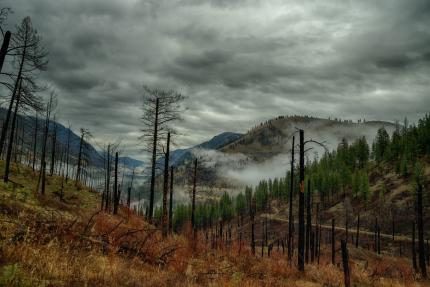
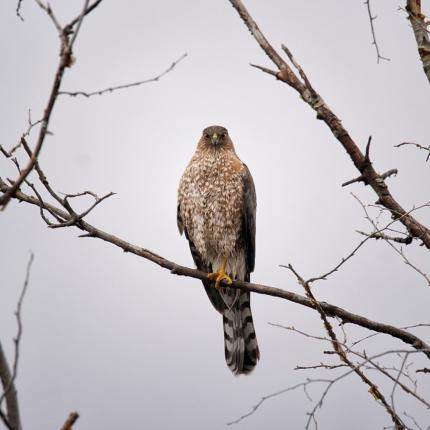
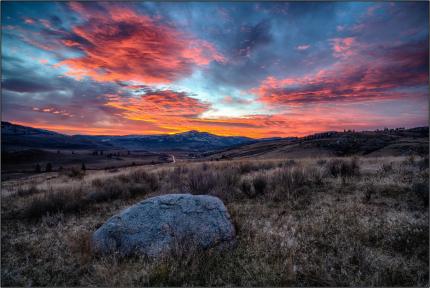
Managing Wildlife Populations
District 8 Bobcat Research: A five year research study has commenced in District 8 to investigate bobcat populations. District 8 Biologist Wampole assisted Science Division Researcher Kerston and Statewide Furbearer & Bear Specialist Welfelt in establishing an active trapline for bobcat to deploy GPS collars. Locational data from GPS collars will help inform bobcat habitat use. So far one healthy male has been captured and collared. However, that individual has been recaptured in other traps along the trap line. The project aims to deploy 12 to 15 collars in the district this winter season.
Kittitas County Deer Collar Collection: District 8 Wildlife Biologists Wampole and Moore have been out collecting dropped deer collars in Kittitas County. These collars were deployed in 2020 as part of the Wenatchee mule deer project investigate migratory movement of mule Deer. The collars have integrated drop off mechanisms which self-release three years after capture before the battery in the collar dies. Collars have a black band, two gray boxes, and a metal label with Washington Department of Fish and Wildlife on them. If you find one, please report it to the Region 3 Washington Department of Fish and Wildlife office in Yakima.
District 8 Fisher Project: District 8 Wildlife staff members have been busy processing trail camera photos for the South Cascades Fisher Project. The project is trying out AI technology from wildlife insights to make the process more efficient.
District 8 Bat Hibernacula Counts: District 8 Biologist Wampole, Statewide Bat Specialist Tobin, and U.S. Forest Service partners conducted bat hibernacula counts at Boulder Cave, Naches to monitor trends in the Townsend big-eared bat population.
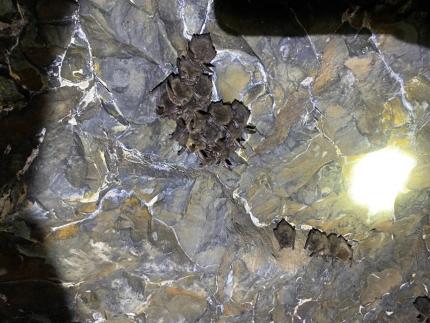
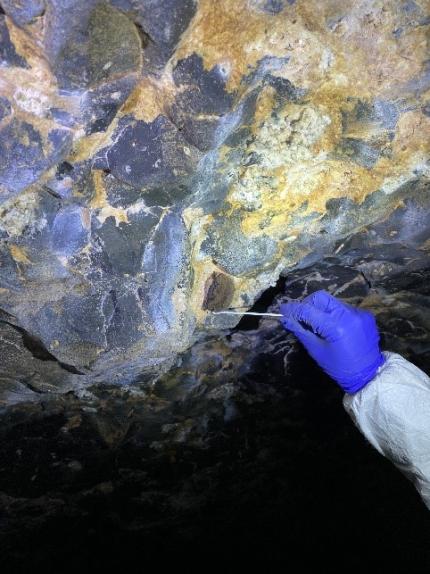
Elk Feed site Counts/Composition: District 8 Biologist Wampole and wildlife area staff members conducted counts and composition of wintering elk at Robinson, Watts, and Oak Creek feedlots. Counts and compositions (for example calf to100 cow ratio) are used to help inform population status and trends.
L.T. Murray Elk Feeding: Natural Resource Scientist Nass and Natural Resource Technician Blore continued feeding elk at the Joe Watt and Robinson Canyon feed sites.
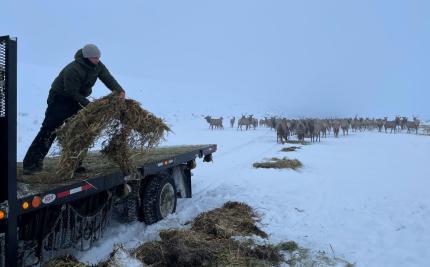
Oak Creek Wildlife Area Winter Feeding Operations: Oak Creek Wildlife Area staff members continue feeding elk on Cowiche Unit and Oak Creek Unit of the Oak Creek Wildlife Area. Current counts indicate an average total of 2300 elk on the Cowiche feed site and 550 elk on Oak Creek feed site are being fed daily.
District 4 Cougar Sealing: District 4 Wildlife Conflict Specialist Hand sealed a cougar for a hunter who harvested the cat in the Blue Mountains Game Management Unit (GMU) 166.
Rattlesnake Hills Elk Survey: District 4 Wildlife Biologist Fidorra coordinated and started the winter elk survey of the Rattlesnake Hills sub-herd. After one day of flying, weather delayed the survey until February. District 8 Assistant Wildlife Biologist Moore assisted with surveys, and Region 3 staff members conducted flight following.

District 4 Bobcat Sealed: District 4 Wildlife Biologist Fidorra sealed a bobcat harvested from Rattlesnake Hills GMU 372. While bobcat are occasionally reported from this area, this is the first time that Fidorra had sealed a cat from the Yakima River Valley.
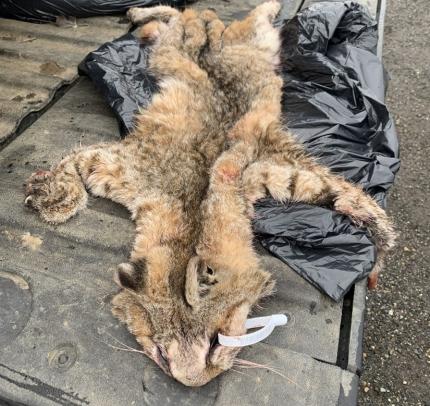
Providing Recreation Opportunities
Wenas Wildlife Area Sheep Company Target Shooting Area: Wenas Wildlife Area Lands and Recreation Specialist Frame collected 160 pounds of target shooting waste and material. Since recent clean-ups, the target shooting area has significantly less trash than the previous month. Items found were target shooting material, wood, metal, carboard, and a human shaped mannequin.
Wenas Wildlife Area Manastash Ridge Trails / Durr Rd - Kiosk and Trail Conditions Sign: Wenas Wildlife Area Lands and Recreation Specialist Frame has received approval from Kittitas County to install a trails condition sign and an information kiosk. The trails conditions sign will indicate to trail users the current conditions of the trail. The Durr Road kiosk will provide space for Washington Department of Fish and Wildlife to display important information regarding the Wenas Wildlife Area. Once weather conditions improve, the sign and kiosk will be installed.
Windmill Ranch Youth Hunt: Youth hunters over the weekend had successful hunts throughout the Sunnyside-Snake River Wildlife Area, including the Windmill Ranch Unit. There was an abundance of waterfowl throughout the wildlife area.
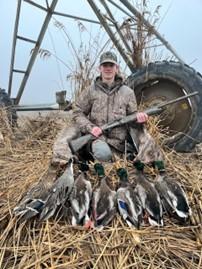
Providing Conflict Prevention and Education
Rattlesnake Hills Elk: District 4 Wildlife Conflict Specialist Hand monitored elk activity on Rattlesnake Mountain including the Hanford National Monument and surrounding private lands. Access to higher elevations were limited by foggy weather and snow and icy road conditions.
District 4 Deer Damage: District 4 Wildlife Conflict Specialist Hand continued working with deer damage issues from wheat producers in the Kahlotus and Paterson area on hazing, damage permit hunting, and possible youth hunting opportunities.
Kittitas County Conflict: District 8 Conflict Specialist Wetzel hazed some elk from agriculture areas in Kittitas County. Elk ventured to areas in Thorp, Vantage, Kittitas, Badger Pocket, and Cle Elum, mostly visiting haystacks and domestic animal feeding areas. No major issues were reported on I-90 though elk were seen crossing the freeway and feeding on both sides of the interstate. Wetzel received calls about a wolf visiting bone piles in the north Kittitas Valley area. No conflict issues were reported regarding the wolf.
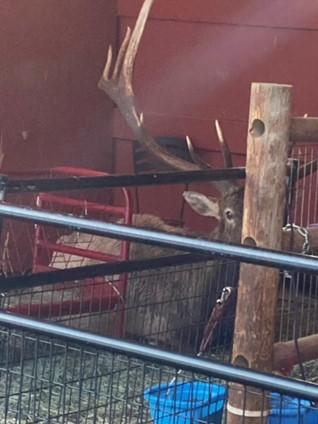
Yakima County Conflict: District 8 Conflict Specialist Wetzel worked on fencing contracts with growers who were having problems with elk in orchards and one crop circle. Elk have been hazed from orchard areas. Elk have been breaching fences and crossing cattle guards in the Cowiche area as well as Tampico, Naches, and Tieton.
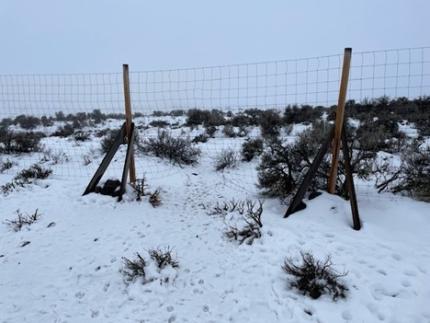
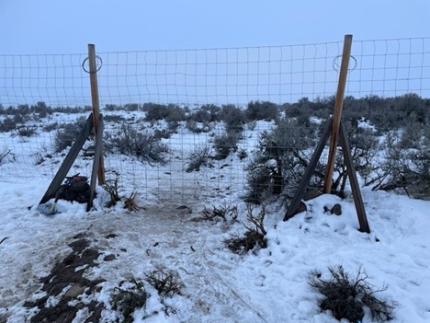
Providing Education and Outreach
Tri-Cities Sportsmen Show: Region 3 wildlife staff members worked the agency booth at the Tri-Cities Sportsmen Show. Sunnyside-Snake River Wildlife Area Manager Kaelber, District 4 Wildlife Conflict Specialist Hand, Region 3 Private Lands Biologist Manderbach, District 4 Wildlife Biologist Fidorra, and Region 3 Wildlife Program Manager Huffman represented the Wildlife Program among many Fish, Habitat, Enforcement, and administrative staff members throughout the weekend. Many questions were fielded, the trivia wheel was a hit, and lots of agency swag was given out.
Oak Creek Wildlife Area Public Outreach: Oak Creek Wildlife Area Manager Mackey, Assistant Manager Charlet, and many other Washington Department of Fish and Wildlife staff members have completed a project to redevelop a winter-feeding brochure. The new brochure outlines important information regarding public viewing opportunities for elk and bighorn sheep feeding on the Oak Creek Wildlife Area. It is now available at the Oak Creek Visitor Center and the Region 3 office.
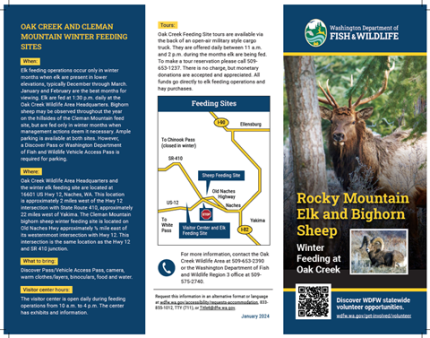
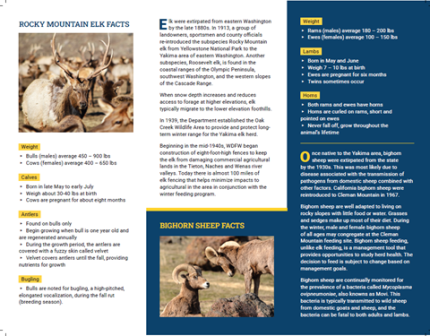
Conducting Business Operations and Policy
Wenas Wildlife Area Maintenance: Wenas Wildlife Area Natural Resource Technician Janes added a new gate latch to the gate in the elk fence at the Black Canyon access and continued working in the shop building a wire roller while continuing to learn about the winter-feeding operations. He also built a bale spear for the skid steer as a backup in case there is an issue with the tractor that cannot be resolved in a timely manner.
L.T. Murray Funding: L.T. Murray Wildlife Area Manager Morrison and elk feeding staff members met auditors at the Joe Watt and Robison Canyon feed sites to show them how Pittman-Robertson Grant funds (PR funds) are being spent on the L.T. Murray Wildlife Area. They also looked at some equipment that had been purchased using PR dollars. This type of audit takes place once every five years and went really well.
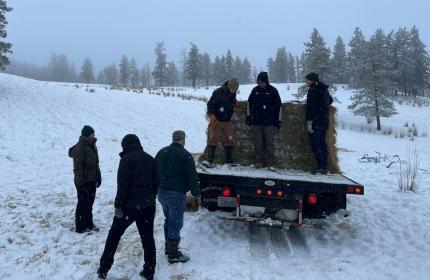
Other
Sunnyside-Snake River Maintenance: Sunnyside-Snake River Wildlife Area staff members continued to conduct routine maintenance of access sites on the wildlife area, including maintenance of registration kiosks, wetlands, water control structures, and waterways.
Yakima Pesticide Recertification: Region 3 Private Lands Biologist Manderbach attended day one of the Washington State University Pesticide Education Recertification Program at the Yakima Convention Center. Day one topics included Emerging Pests, Washington State Department of Agriculture Compliance, Enforcement Highlights, Pesticide Product Stewardship and Disposal of Unwanted Products, Management Strategies for Common Pathogens of Urban Landscapes in the Inland Pacific Northwest, The Impacts of Pesticides on Pollinators and How to Protect Them, and Ticks and Other Non-Insect Arthropods of Medical and Urban Concern. The topics were informative and useful and the day was worth six pesticide recertification credits.
Managing Wildlife Populations
Marbled Murrelet Diet Analysis Research: Regional Wildlife Biologists assisted Science Division with murrelet captures for an ongoing diet analysis to help assess factors associated with local population declines. The team found success in the waters near Smith and Minor islands, west of central Whidbey Island, capturing three marbled murrelets and one ancient murrelet in a single evening!
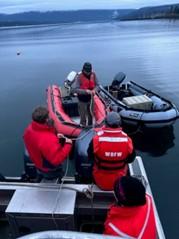
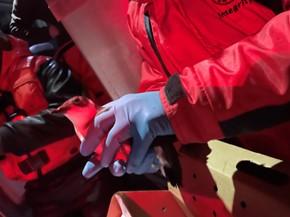
Cascades Bobcat Project: Biologist Smith has been helping Wildlife Science Division trap bobcats in King County. The effort aims to develop occupancy modeling tools to provide for periodic population trend assessment in this species.
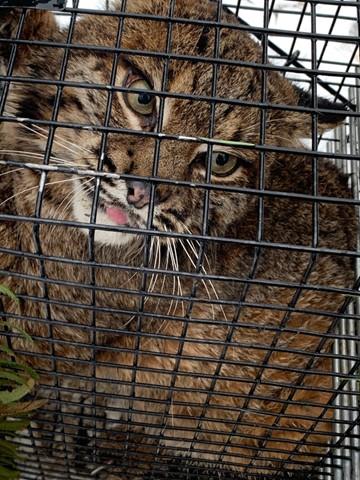
Managing Wildlife Populations
Midwinter Aerial Seabird Surveys: Regional and Waterfowl Section biologists took to the skies to continue the long-term monitoring effort to document the abundance, trends and distribution of marine birds and mammals in the Puget Sound and Strait of Juan de Fuca. The team completed all surveys by the end of January, which is no small feat considering the amount and length of survey transects (blue and red lines in map below). Check out the survey data!
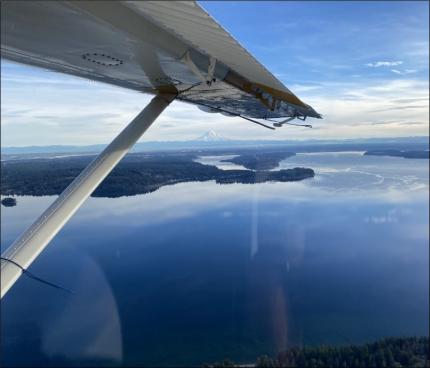
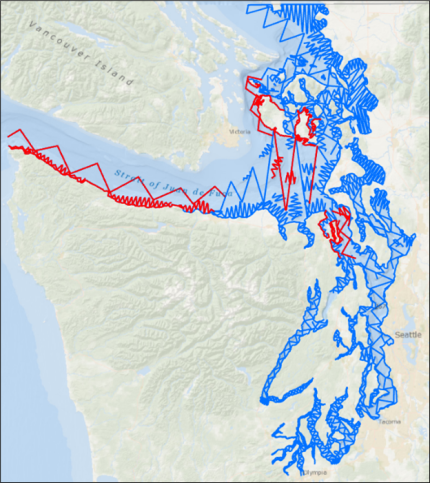
Port of Seattle Terminal 91: Biologist Anderson met with Port of Seattle and King County environmental staff members regarding the need to remove a creosote piling in the Terminal 91 area. They discussed the effects to the purple martin colony at the site. This project is part of a larger revisioning and redevelopment of that area.
The Port is examining alternative, steel piling sites in Elliott Bay, Duwamish Waterway, and on site at Lake Jacobs, between and just north of Terminal 91 and Terminal 90. These alternative sites seem, initially, to be good alternatives. If they are used, they would provide for similar alternate purple martin nest site opportunities for the greater Elliott Bay population of this state species of greatest conservation need. The local martin population along the Seattle waterfront has the largest concentration of martins in King County.
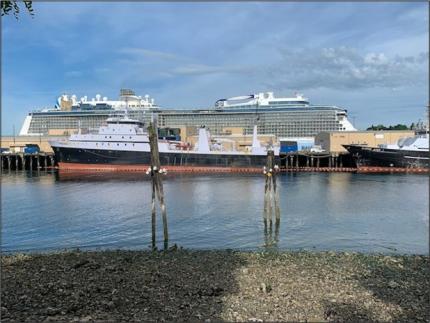
West/East of Cascade Crest Bobcat Study: Biologist Smith assisted Scientist Kertson with ongoing bobcat trapping in District 12.
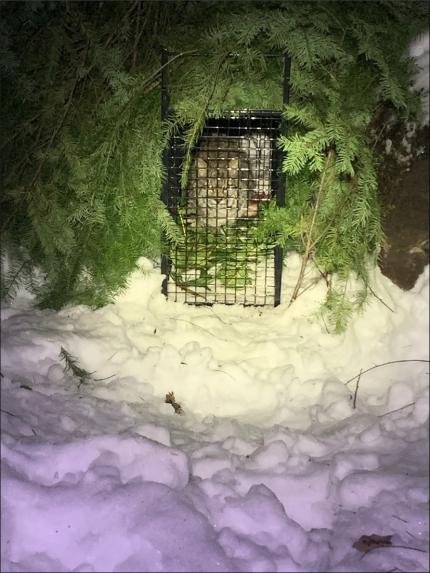
Trumpeter Swan Project: Biologist Smith assisted in captures of swans related to a new forage and spatial use study.
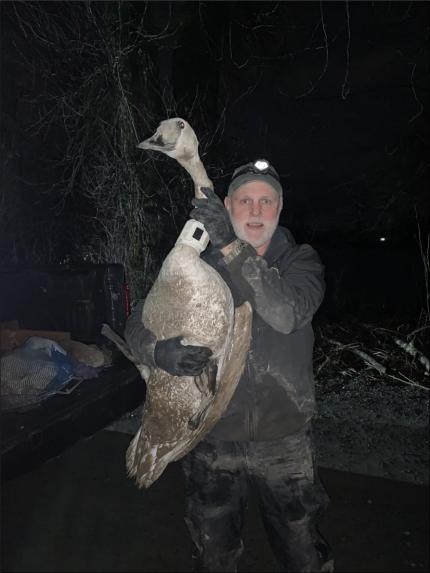
Providing Conflict Prevention and Education
SeaTac International Airport Wildlife Hazard Management Plan Annual Meeting: Biologist Anderson met with Port of Seattle at their annual overview of the SeaTac International Airport Wildlife Hazard Management Plan. Aspects of the plan discussed involved largely bird airstrike hazard management, state and other jurisdictional legal considerations and needs, how efforts are implemented on the ground/changes/etc., broad assessment of how things are going, and where attention is needed in 2024.
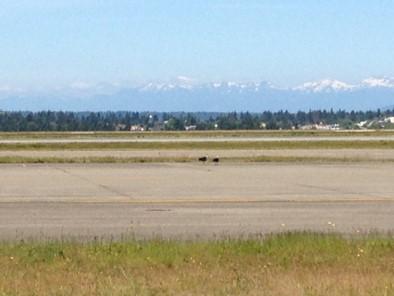
Providing Education and Outreach
Burien Bird Fest, Bellevue Master Naturalist, King County Native Plant Sale: Biologist Anderson tabled with Watchable Wildlife at the Burien Bird Fest. The event was very birdy and well attended at the Washington Department of Fish and Wildlife (WDFW) outreach table.
Biologist Anderson provided the annual Urban Wildlife Management class for the Bellevue Master Naturalist Program.
Anderson partnered with Habitat at Home to run a table at the King County native plant sale. There were many plants being picked up and many folks visiting the WDFW booth to discuss wildlife and our Habitat at Home Program.
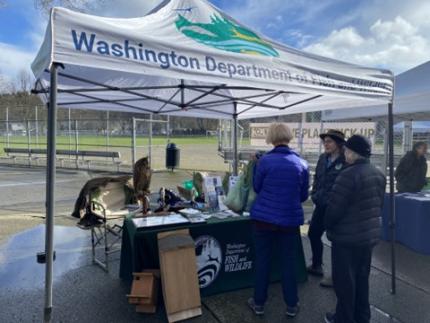
Conducting Business Operations and Policy
Northern Spotted Owl, South Fork Tolt Federal Energy Regulatory Commission Relicensing, Bat Box, Secretive Wetland Birds: Biologist Anderson participated in ongoing meetings regarding internal and external working groups, which all kicked-off in the new year. Looking forward to contributing and helping with working group needs and decisions.
Managing Wildlife Populations
Klickitat Mule Deer Aerial Survey Results: During the week of Dec. 11, Biologists Wickhem, Bergh, Holman, Jacobsen and Bundick conducted annual helicopter surveys for mule deer in GMUs 388 and 382. The survey consists of flying transects over 15 randomly selected survey units in Klickitat County between the Klickitat River and the eastern boundary of the county.
When a group of deer is located, they are counted and classified (age, sex, and number of antler points, if present). Several other covariates are also collected including vegetation type, amount of cover, amount of snow, etc.
Since the surveys were completed, Biologist Wickhem has been entering and analyzing data using the Idaho Sightability Model, a statistical model that uses the counts and covariates to estimate a population for the survey area. The model estimated that GMUs 382 and 388 have approximately 7,978 deer. There is considerable error in this estimate since the vegetation types used in the Idaho Sightability Model do not directly translate to the Washington landscape, however it is the closest model that currently exists.
We can still use these estimates along with harvest to monitor trends in the population. After dropping significantly from 2016 to 2017 following an extremely harsh winter, the population estimates have remained relatively stable. Since 2017, managers have removed nearly all anterless hunting opportunities in an attempt to rebound the population. On the upside, the estimated ratios of fawns and bucks for every 100 does were 56 and 23, respectively. Fifty-six fawns for every 100 does is on par with previous surveys and 23 bucks is the highest recorded buck to doe ratio since surveys began in 2016.
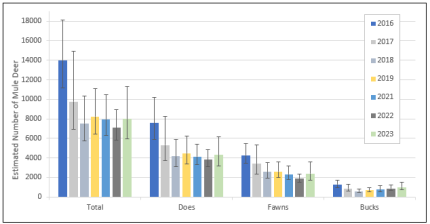
GPS-collared Mule Deer Mortalities: Biologist Bergh and Wildlife Conflict Specialist Jacobsen had a snowy adventure to GMU 382 to retrieve the GPS collars from two study deer that had died the previous week during the snow and ice storms. One of the deer was still completely intact and had been covered in snow until recently and the only parts left to the other deer were the spine, some ribs, and two legs. That deer had been scavenged by a coyote and several birds, so a cause of death was unable to be determined. The intact deer had diarrhea on her tail and there was bloody diarrhea nearby. Samples of the organ tissues were sent to the Washington Animal Disease Diagnostic Lab at WSU to test for evidence of disease.
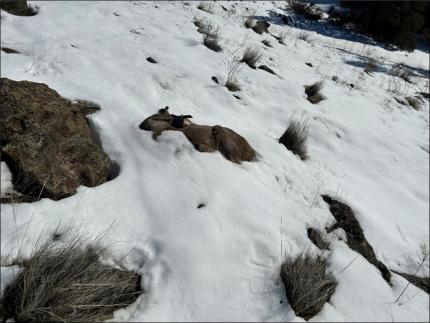
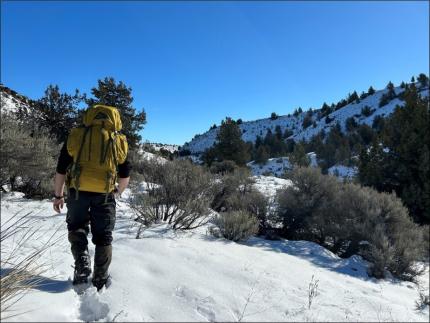
Biologist Wickhem, Wildlife Conflict Specialist Jacobsen, and Volunteer Zoller responded to another “mortality signal” from a GPS collared deer later in the same week, this one in GMU 388. This retrieval required an approximately four-mile round trip excursion on snow-covered roads, that Wickhem thoroughly enjoyed on her skis, while Jacobsen and Zoller post-holed. Despite responding to the location as soon as possible, only one small piece of ribcage was found at the mortality location, making it impossible to determine the cause of death. The crew was able to locate the collar using radio telemetry, after a coyote carried it 400 yards from the carcass remains and buried it in the duff under a tree.
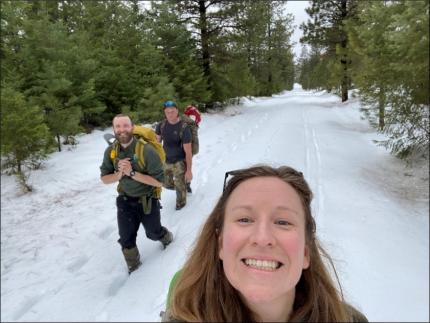
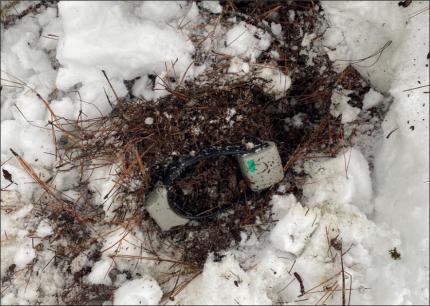
Injured Owl: Wildlife Conflict Specialist Jacobsen received a report regarding an injured great horned owl in the Goldendale area that needed transport to a rehabilitation center. Jacobsen responded to the residence and determined the owl was actually a western screech owl, which is substantially smaller than a great horned owl. The owl was in poor condition due to its wing having been wedged between two buildings – the owl dangled there for several days until the homeowner noticed it and freed it. Jacobsen transported the owl to Rowena Wildlife Clinic in Oregon, where it received treatment for its injuries.
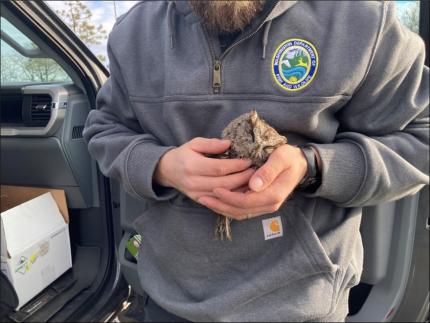
Cascade Red Fox Report: Wildlife Conflict Specialist Jacobsen was contacted by a member of the public regarding a possible sighting of a Cascade red fox along the Idaho border. Jacobsen confirmed that the fox was a lowlands red fox, not a Cascade red fox. The Cascade red fox only inhabits alpine and subalpine habitat in the south Cascades and has a population size that is estimated to be around 50 individuals.
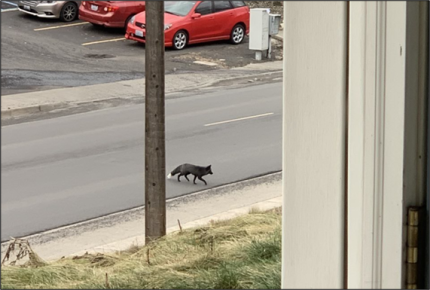
Track Survey: Wildlife Conflict Specialist Jacobsen accompanied Biologist Spence on a wolf track survey in the Gifford Pinchot Forest via snowmobile. Tracks of snowshoe hare, coyote, and cougar were observed, but no wolf tracks were detected.
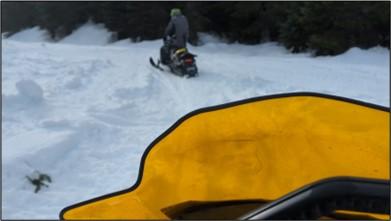
Hunter Harvest Checks: Hunting seasons for some species continue. Regional wildlife biologists, wildlife conflict specialists, and customer service specialists continue to make checks of hunter harvested wildlife that have seasons continuing into the winter months. Many species of wildlife, including cougars and bobcats, have various checking requirements to facilitate biological sample collection and assure the legality of harvests. Hunters are reminded to check the Big Game Seasons Pamphlet in order to be clear on checking requirements for various species as well as season dates.
During this reporting period, Biologist Holman and Biologist Wickhem checked two cougars each. Wildlife Conflict Specialist Jacobsen checked a sub-adult male cougar from GMU 382 and a male bobcat from GMU 388.
Providing Conflict Prevention and Education
District 9 Cougar Sighting Report: Wildlife Conflict Specialist Jacobsen fielded a report of a cougar sighting in a residential area of Klickitat County. Jacobsen confirmed the sighting after viewing a video of the cougar.
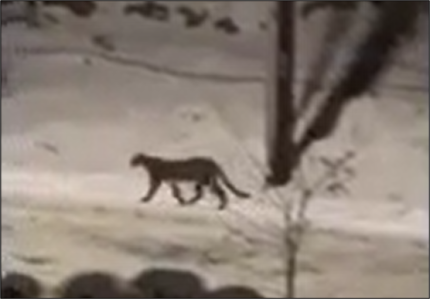
District 9 Habituated Bear: Over the past two months, Wildlife Conflict Specialist Jacobsen responded to multiple complaints in eastern Clark County regarding a large black bear that had been accessing human food sources. Jacobsen worked with multiple landowners to correct improperly secured attractants, but the bear continued to seek out potential sources of food and eventually began ripping apart structures in search of food.
Normally, bears should be hibernating at this point in the season due to the widespread lack of available forage during the winter. Jacobsen determined that this bear had been habituated to accessing human food and attractants such as bird seed, likely over multiple years, based on landowner reports. Given that the bear had decided to “skip” hibernation this year, the lack of available natural forage in the area, the lack of suitable relocation sites in winter, and the level of damage the bear had been causing and degree of habituation he was exhibiting.
Jacobsen eventually trapped and lethally removed the 260 lb. male bear. This was an extremely unfortunate incident that likely could have been prevented if the landowners in the area had responsibly secured their attractants to prevent the bear from accessing them.
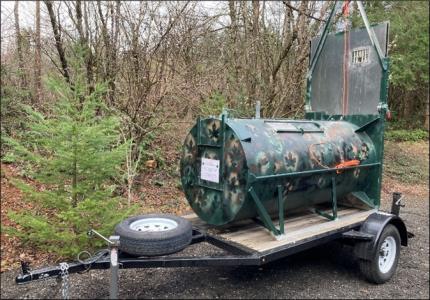
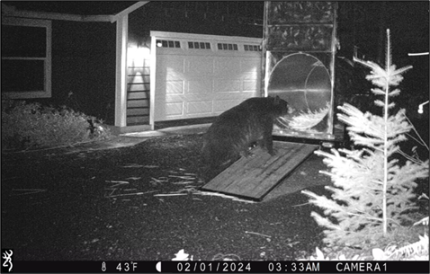
District 9 Cougar Encounter: Wildlife Conflict Specialist Jacobsen and Officer Bolton responded to an incident where an antler shed hunter had a close encounter with a cougar and ended up killing the cougar with his sidearm.
The shed hunter inadvertently came across the cougar while hiking through the woods. Unbeknownst to the shed hunter, the adult female cougar was feeding on a deer kill when the shed hunter passed by. The shed hunter looked up and saw the cougar roughly 30 yards away. At that point, the shed hunter stopped walking forward and began to back up, while chambering a round in his sidearm. The cougar, likely trying to scare the shed hunter away from her kill, turned towards the shed hunter and flattened her ears back in a defensive posture. Fearing for his safety, the shed hunter fired a shot at the cougar. The cougar began running towards him while the shed hunter continued firing his sidearm. The cougar eventually ran past the shed hunter and died from multiple gunshot wounds a short distance past the hunter.
This chain of events is extremely uncommon and was likely due to the cougar trying to scare the shed hunter away from her kill. Washington Department of Fish and Wildlife encourages outdoor recreationists to be prepared to encounter wildlife such as cougars by carrying bear spray as well as by being familiar with cougar habits and behavior. If a cougar is encountered in the wild, recreationists are encouraged to make loud noises, appear as big as possible, and give the animal its space. More information on encountering cougars in the wild can on the WDFW website.
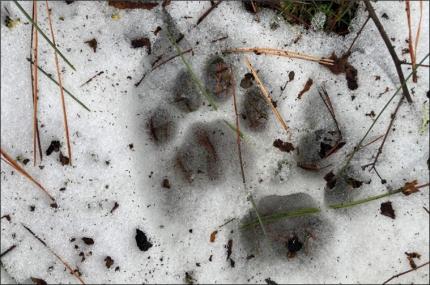
District 9 Elk Damage to Hay Field: A landowner contacted Wildlife Conflict Specialist Jacobsen regarding elk damage to a hay field. The landowner has had a poor hay crop on the field for the past few years due to persistent elk damage and requested a Master Hunter from the Region 5 elk damage pool to assist in lethally removing the elk from the property. Jacobsen deployed an elk hunter to the property, who harvested a hoof-diseased elk within a short time of his arrival at the field. This particular elk group has had a high prevalence of Treponeme-associated hoof disease (TAHD) among individuals there for several years.
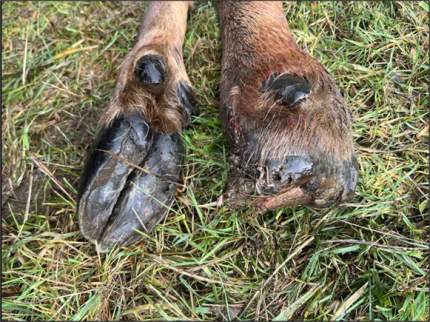
Conserving Natural Landscapes
Charismatic Mini-fauna on Mount Saint Helen’s Wildlife Area: When we first think of managing wildlife areas, we typically think of managing habitat for large and/or well-known species like elk and waterfowl. However, Wildlife Areas provide important habitat for a variety of species. While working on the Mount Saint Helen’s Wildlife Area, Assistant Manager Risley and Technician Crane observed some of the charismatic mini-fauna that call the wildlife area home.
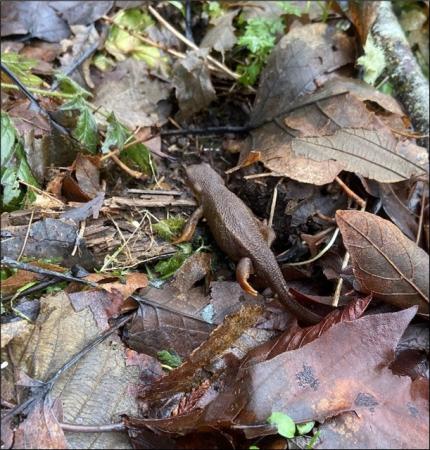
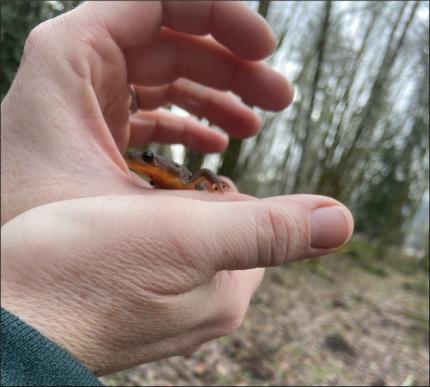
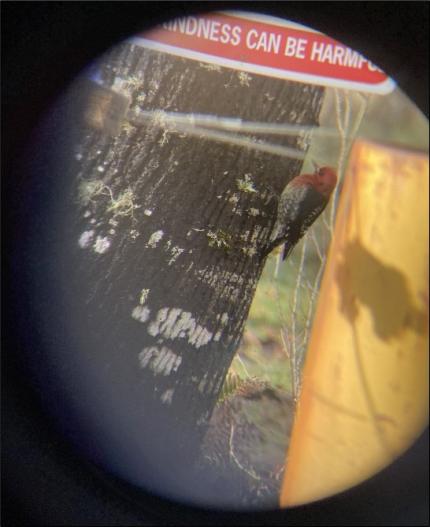
Managing Wildlife Populations
Deer and Chronic Wasting Disease: At the request of Washington Department of Fish and Wildlife Veterinarian Haman, Biologist Tirhi met with a hunter who harvested a deer in Colorado that tested positive for chronic wasting disease. Following protocol, Tirhi collected and disposed of the meat and educated the hunter about decontamination requirements.
Western Pond Turtle: Biologists Butler and Tirhi represented Region 6 at the annual Northwestern Pond Turtle Partners Annual Meeting which was attended by Washington Department of Fish and Wildlife’s Region 6, Region 5, and Olympia headquarters staff members, U.S. Fish and Wildlife Service, Woodland Park Zoo, Oregon Zoo, PAWS, Sustainability in Prisons Project, and our citizen scientists. This is the annual opportunity for Washington Department of Fish and Wildlife and its partners to discuss and plan the past and upcoming turtle seasons and all things related to turtle recovery.
Oregon Spotted Frog Working Group: Biologists Butler and Tirhi represented District 11 at the annual Washington working group meeting hosted at U.S. Fish and Wildlife Service headquarters. The meeting was well attended by federal, state, county, and non-government organizations, including academia and citizen science partners. This meeting is our annual opportunity to review, discuss, and plan all things related to spotted frog recovery in Washington. Washington Department of Fish and Wildlife is grateful for the excellent partnerships protecting this most amazing and precious frog (Rana pretiosa, meaning "precious frog").
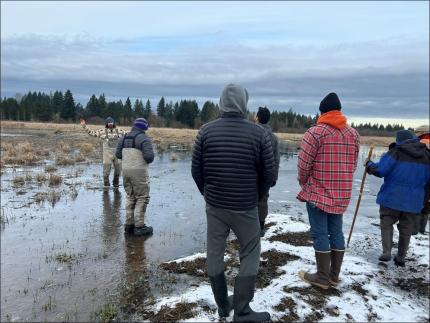
Oregon Spotted Frog Hydrology Monitoring: Biologist Tirhi completed the weekly hydrology monitoring at our Salmon Creek frog breeding site. This monitoring provides information on the success of the frog restoration work, including the control of invasive reed canary grass. Fall and winter rains have returned and are filling the wetlands and should provide adequate levels for successful spotted frog breeding. Temperatures suggest that the frog season may start earlier this year.
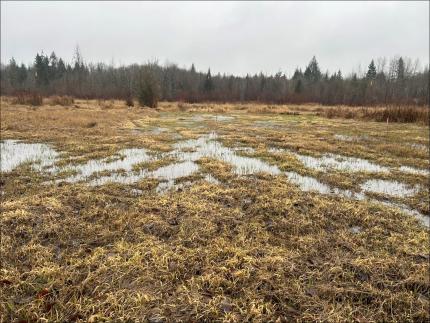
Marbled Murrelet: Biologist Tirhi assisted Olympia headquarters staff members with one evening session of murrelet captures on various parts on the Puget Sound. Although they did not capture any murrelets on this outing, one was seen towards the end of the survey but flushed before being caught. Tirhi and Butler will be assisting again in February.
Sea Duck, Marine Bird Surveys: Biologist Murphie participated in the annual Puget Sound Ecosystem Monitoring Program winter marine bird and mammal survey effort, as a primary observer. These surveys have been conducted since 1992 and sample the inland marine waters of Washington. Biologist Murphie has participated in this effort since 1995. Observers identify and count all birds and marine mammals seen within a fifty-meter strip on either side of the survey aircraft. The current survey track line extends about 4,000 miles. The survey effort was completed on Jan. 30.
Grouse Wing and Tail Collection Barrels: Biologist Murphie placed grouse wing collection barrels at two locations in District 15 prior to the grouse season opener in September. They were located at Simpson Mill 5 near Matlock and at the George Adams Hatchery north of Shelton during the entirety of the grouse hunting season and 24 samples were collected. Both barrels were removed after the season ended.
Goose Surveys: Biologists Cent and Novack conducted their bi-monthly dusky Canada goose surveys across Grays Harbor and Pacific counties.
Swan Surveys: Biologist Cent conducted another tundra and trumpeter swan count since, the first survey resulted in a low count total of 52 swans. Sometimes the swans are simply in a location that we are unaware of or do not have visual access. The second count resulted in 104 swans.
Plover Survey: Biologist Cent and Diversity Biologist Anholt surveyed multiple coastal sites for wintering snowy plovers in coordination with surveys across Oregon and California. A total of 38 wintering plovers were recorded at Midway and along the beach north of Ocean Shores. At least four banded plovers were seen. They hope that additional birds will be seen by U.S. Fish and Wildlife Services at Leadbetter and the Shoalwater Tribe at Graveyard/Empire spit.
Auklet Reports: Biologist Cent responded to a report of dead auklets along the beach in Ocean Shores. One carcass was retrieved for disease testing.
Providing Recreation Opportunities
Grays Harbor Access Areas Clean up: Access staff members continue to deal with dumping at Grays Harbor Access Areas, specifically: Morley-Humptulips River, Longs Swamp-Wishkah River, and Fuller Bridge-Chehalis River. Pictured below are just a few of the recent illegal dump sites that have occurred on Department of Fish and Wildlife properties in recent weeks.
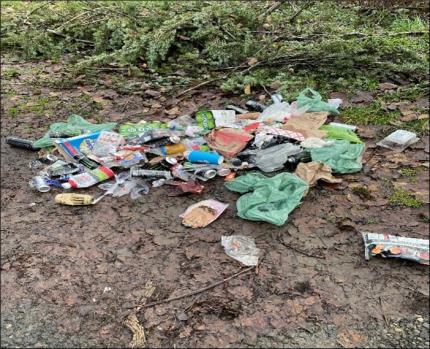
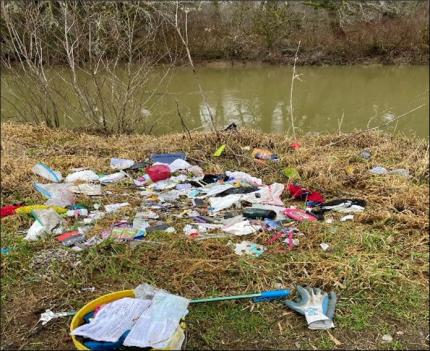
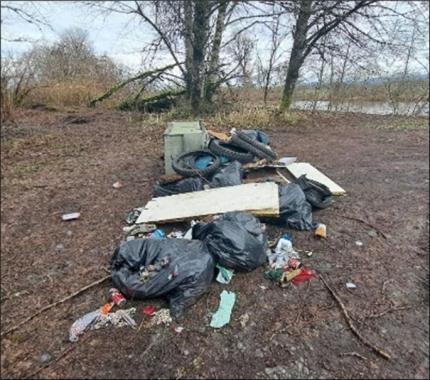
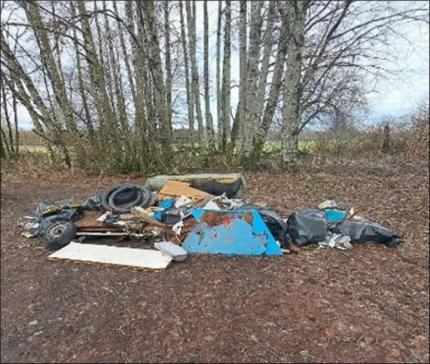
Reynvaan Bar-Humptulips River: Access staff members with the assistance of the neighboring timber company’s logging equipment and behind the scenes work by Region 6 Enforcement officers were finally able to remove and dispose of an abandoned travel trailer that was forcefully dragged through a jeep trail until it was hung up in between trees in a wooded area of the site and came to rest on the property boundary. The additional help was definitely needed to accomplish this task. The loader was able to dismantle and load the travel trailer in two dump trailers for removal.
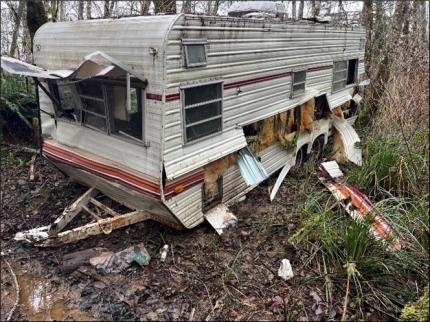
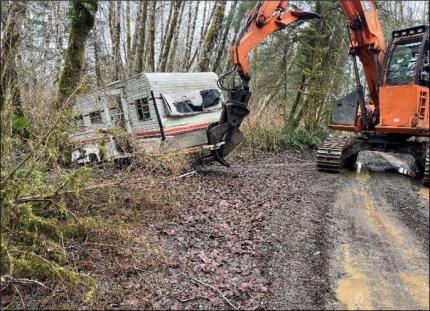
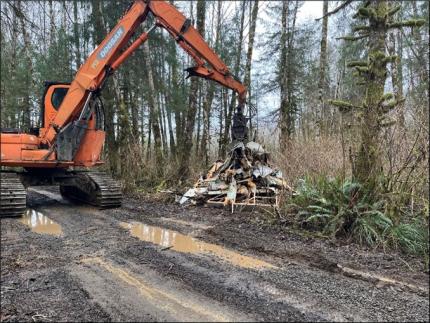
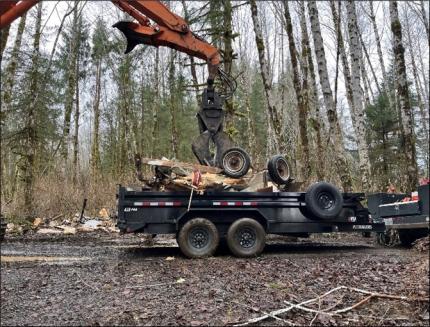
Lake Tahuya Access Area, Mason County: Access staff members made concrete forms and placed removable bollards at the recently developed Lake Tahuya site. The bollards are located atop of the access trail, the trail and access were designed for hand launching only. The bollards were placed to ensure vehicles do not attempt to access the water. However, they are locking and removable when needed for planting fish or facility maintenance.
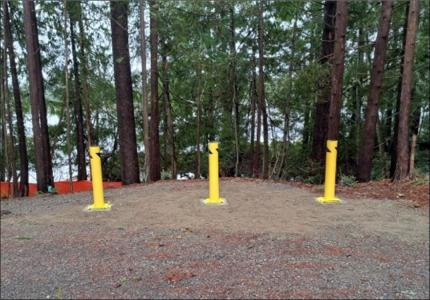
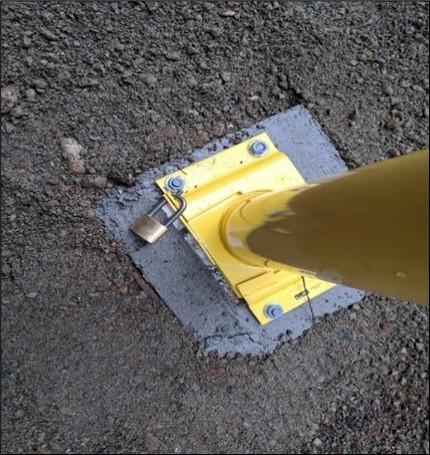
Treponeme-associated Hoof Disease Permit Hunters: Biologist Novack has checked the hooves from various Master Hunter permittees and issued renewal letters for those submitting abnormal hooves. The renewal letters allow the Master Hunter to use their unused general season tag to try and harvest a second treponeme-associated hoof disease (TAHD) infected elk.
Conserving Natural Landscapes
Elk River Wetland Planting: District Biologist Novack, Assistant District Biologist Cent and Wildlife Area Manager Bechtold assisted Wildlife Area Technicians Magliaro and Martinez to complete a 2-acre wetland planting project in the Elk River Unit of the Olympic-Willapa Hills Wildlife Area. The project took about two months to complete in total. The project entailed the installation of roughly 200 large willow and cottonwood cuttings, as well as constructing and installing protective cages to prevent damage from beaver, nutria, elk, etc. This project is part of a larger habitat enhancement project at the Elk River Unit, funded by the Washington State Recreation and Conservation Office, with upland, wetland, and riparian aspects.
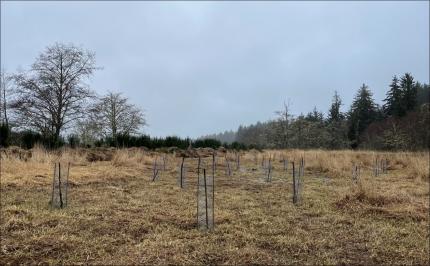
South Puget Sound Management: Technician Morgan and Wildlife Area Manager Laushman continued weed management activities at the South Puget Sound Wildlife Area in Lakewood, specifically mowing Scotch broom to open up native populations of lupine and pulling patches of spurge laurel.
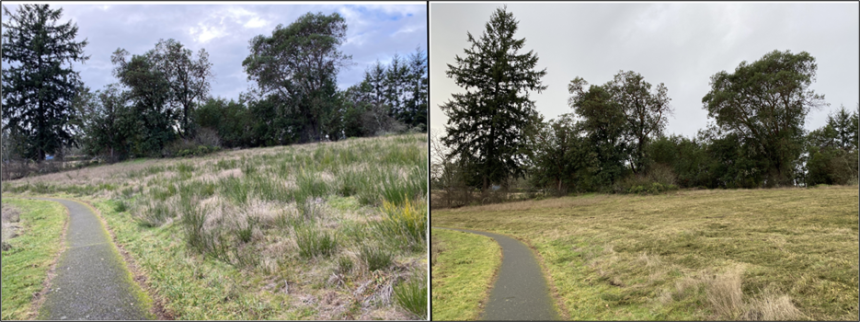
Theler Wetlands: The Hood Canal Salmon Enhancement Group’s Washington Conservation Corps crew removed invasive plants around the Theler Wetlands at the Union River Wildlife Area. These included large swaths of blackberry and hanging sedge around the Theler Community Center buildings.
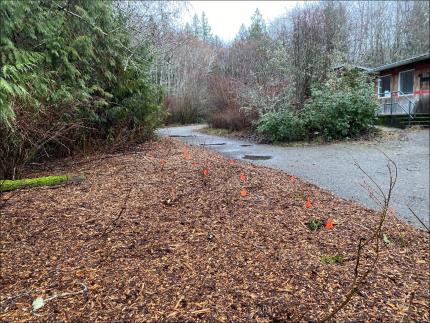
McNeil Plantings: The Nisqually Tribe’s planting crew helped wildlife area and Habitat Program staff members replant the Milewa Estuary restoration area on McNeil Island. The estuary was restored in 2022 and new native shrub species were provided by partners at the U. S. Fish and Wildlife Service to help restore the disturbed banks.
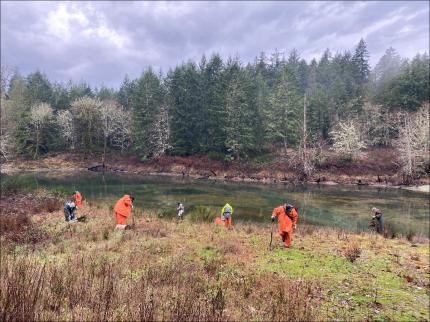
Joint Base Lewis-McChord Integrated Natural Resource Management Plan. Biologist Tirhi spent considerable time reviewing and providing edits to the draft integrated natural resource management plan (INRMP). The INRMP guides natural resource management across the Department of Defense Joint Base Lewis-McChord (JBLM) Installation. JBLM contains the majority of remnant south Puget Sound prairie, a habitat that is critical to the recovery of several federally and state listed prairie species including Mazama pocket gopher, streaked horned lark, Oregon vesper sparrow, and Taylor’s checkerspot butterfly. Other priority species also rely on this area, in particular native prairie butterflies. For this reason, the INRMP plays a critical role.
Providing Education and Outreach
Puyallup Sportsmen’s Show: Biologist Novack and Butler staffed the Washington Department of Fish and Wildlife booth at the Puyallup Sportsmen’s show on Jan. 31 and interacted with a large number of hunters. Public inquiries ranged from questions about where to apply for special permits to, what is going to happen with grizzly bears.
Falconry Opportunities: Wildlife Area Manager Laushman met with a local falconer to discuss wildlife areas suitable for hunting with his red-tailed hawk, Ruby.
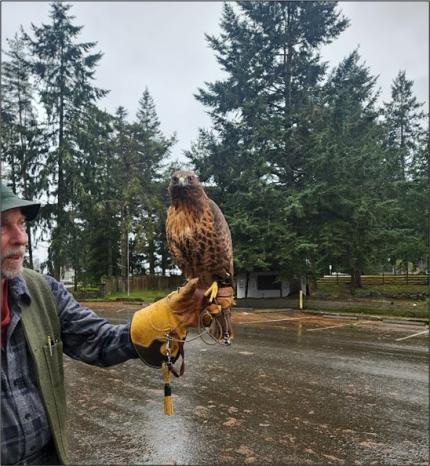
General Wildlife Inquiries: Biologist Murphie responded to inquiries received by phone or email related to duck hunting, osprey nest removal, river otters, and bird watching.